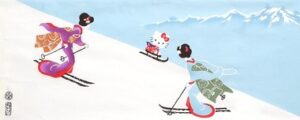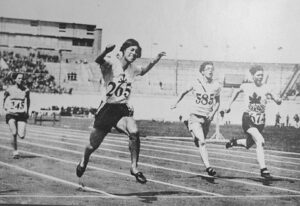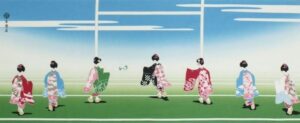Chapter scope: This chapter explores humorous visual texts found in two prominent Kyoto sites: the legendary textile firm Eirakuya and the Kyoto International Manga Museum. The chapter shows maiko pictured in absurd situations, even playing sports in full costume. Some are morphed with animals, other kinds of people or characters, and even a vegetable. Reading these images against broad cultural trends, we compare maiko graphics to those of modern girls in the 1930s and girls’ leisure fun in the 2000s.
Overall Discussion Questions: What does this visual comedy tell us about how artists in Japan have understood maiko past and present, and girl culture in Japan more broadly? How do these funny images play with the idea of masquerade? How do they speak to their times?
Reading Questions:
Keep these questions in mind as you read the chapter and organize your thoughts.
We discuss the chapters in two parts: the tenugui art, followed by the manga.
What’s a tenugui?
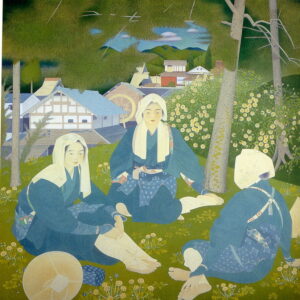
Tsuchida Bakusen: Oharame, 1927. Ink and color on silk, 213×215 cm. National Museum of Modern Art, Kyoto. Wikimedia Commons
How has the tenugui been used in daily life in Japan and by performing artists? Search “tenugui wrapping techniques” online for quick views of tenugui in action.
Sporting Maiko Series, Eirakuya
Looking closely at the sporting maiko design of 1931, describe what you see.
Hit a Homer, Maiko! (p.167). You can find other examples on the Eirakuya website.
What was happening with women and sports in Japan in the 1930s?
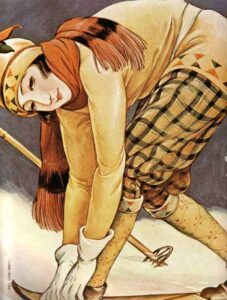
A sporting Kashō girl from a cover of Girls’ Illustrated. Source: Bessatsu Taiyō, Takabatake Kashō: bishōnen, bishōjo gen’ei, Tokyo: Heibonsha, 1985, p. 47. See Barbara Hartley article, “Performing Nation,” http://intersections.anu.edu.au/issue16/hartley.htm
Who was the modern girl?
The chapter gives an overview of the modern girl and scholarship about her presence in Japan and globally. Here, we concentrate on images of her.
Many photographs and posters available online give you a sense of the modern girl in Japan as a character in the public imagination. The chapter has two provocative images:
Looking closely at Suzuki’s New Year’s postcard (p. 168), describe what you see. How does he contrast the modern girl and the maiko?
How does the 1932 Moga design (p. 170) interpret the modern girl as a fashion icon?
How would you compare her to Hollywood vamps such as Clara Bow? (Deborah Shamoon’s article [see at the end of this page] is very helpful here.
What kinds of tensions about the geisha’s role in society were alive in the 1930s?
How does the chapter suggest that the sporting maiko designs spoke to the cultural climate of 1930s Japan? What other interpretations of the design would be possible?
Moving up to the 2000s, we find the sporting maiko theme revived at Eirakuya.
How might the funny image of maiko at the beach reflect media interest in “girls experiences” (joshi keiken)? How do you compare these contemporary tenugui sporting designs to those of the 1930s? What is happening with women and sport today in Japan?
MOVING ON TO MANGA
Group Discussion Activity: After discussing tenugui as a class, try dividing into small groups for this next section, each group taking one type of manga for close looking and discussion. Present your ideas to the class.
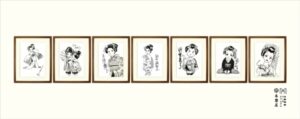
Eirakuya collaborated with Kyoto Intl Manga Museum on this tenugui. http://eirakuya.jugem.jp/?day=20110915
100 Maiko Illustrations at Kyoto International Manga Museum
Get a sense of this space, its mission, and exhibits by visiting https://www.kyotomm.jp/en/
Questions for Section Introduction
* How did the Japan Cartoonists’ Association organize the maiko exhibit?
*How few references to her distinctive look can suggest the cartoon is about a maiko?
*Sarah McConnell helps us think about iconic imagery. She writes, “iconic imagery acts as a trigger for the audience to engage their imagination—a reaction that the author-artist actively seeks to encourage (180).”
*Looking at the various manga displayed in Ch. 6, which do you find most engages your imagination? Looking closely at the image, identify what the triggers are.
Animal + Maiko Manga
What kinds of animals/maiko morphs will you find in the 100 Maiko Illustrations exhibit?
What are the differences among various forms of cute (kawaii, kimo-kawaii, and guro-kawaii)? How might you see these differences in the maiko manga?
According to anthropologist Laura Miller, why do animals in comics, sometimes even in masquerades themselves, appeal to viewers?
What do these animal/maiko morphs say about how we make animals into brand images and mascots? Hello Kitty, the Geico Insurance geko, Snoopy offer other examples.
How do these animal/maiko morphs comment on the maiko as Kyoto character brand?
Maiko Chic
Many manga in 100 Maiko Illustrations play with maiko costume, morphing these with other sorts of girl fashion. A funny one: “High-school graduate maiko.”
Looking closely at this manga, identify the “iconic imagery” used by the artist Sato Masao.
Can you find other comics online of girls’ high school fashion, either in Japan or abroad, to compare this comic with? What messages do they convey?
Artist Terashima Reiko imagines a maiko in the middle of costuming. What does the character’s wink suggest? What did Terashima say about this comic?
Maiko in Kyoto Icon Mash-ups
Compare Hiji Mie’s manga of a Buddhist statue-morphed as maiko with a photo of the actual statue. Search: 大雲院 円山地蔵尊 (Daiun-in Maruyama Jizō son).
What are the boundaries for humorous images of religious icons?
What was Minami Hiroshi’s motivation for creating the daikon maiko?
Maiko-in-Motion
What kinds of manga fit in this category?
Looking closely at Takenaka Ranko’s scooter maiko and Terashima Reiko’s maiko from outer space, notice what’s recognizable about the maiko and what’s odd. What do these maiko suggest to you?
Maiko Jackson
Some manga in the exhibit play with celebrity figures easily recognizable to visitors in 2006. One of the most famous is the late American pop star Michael Jackson. Compare artist Kojiroh’s maiko/Michael with an image in the Michael on the Wall exhibit at the National Portrait Gallery in London.
Granny Maiko
Kuruma Dankichi imagines senior citizen cosplaying as a maiko.
What does his manga have in common with popular fiction about older women in Japan?
How does he play with the image of the tipsy salaryman returning home late at night?
Chapter Wrap-Up
What are the four main points made in the Conclusion?
What did you learn from the chapter about maiko visual comedy?
How did these images shape your understanding of maiko?
What kinds of research would you like to see on visual representations of maiko? What do you hope further research would show?
